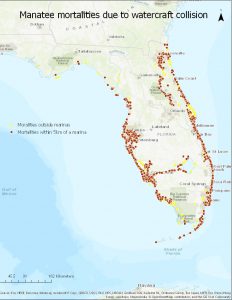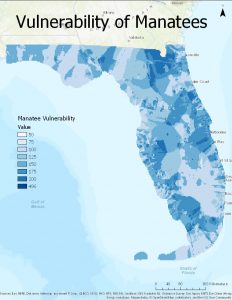Adaptation of Sirenians: Changing Behavior to Allow for Better Thermoregulation
By Sam Aronwald, SRC intern
Through scientific investigation of dugongs in Australia, there is evidence of behavioral thermoregulation in the Sirenia order. A study on two Amazonian manatees (Trichechus inunguis) determined that the average body temperature of all four species that fall under the Sirenia order is regulated between 35.6*C and 36.1 *C (Gallivan, 1983). Out of the four members within the Sirenia order three of the species are types of manatee, while the fourth is the dugong (Dugong Dugon); the last of its family Dugongidae since the 18th century (Wikipedia, 2018). Both the manatees and dugongs have similar morphological and physiological limits on how they maintain a proper internal temperature, despite their varied habitats around the globe. A behavior which dugongs will exhibit to consciously demonstrate thermoregulation is to take a small migration to find warmer waters in the winter (Preen 2004). Even though the waters that they migrate to are low or even empty of any seagrass to support themselves on, they still remain for the majority of winter. This is most likely due to the necessity to escape colder waters for the sake of retaining their body temperatures to a status quo (Preen, 1992).

Figure 1. West Indian Manatee (Source: Unsplash. “Manatee Pictures.” Manatee Pictures, https://unsplash.com/photos/UDdt74azlig.)
Both the dugong and the manatee will travel from one warm area that is abundant with food to another regularly. A prime example is in Central Florida, West Indian Manatees will actually take advantage of human-produced warm water and warm water springs, like the waters that stream from boating canals for the sake of warmer habitats (Edwards, 2016). Thanks to their lower metabolic rates, they are able to feed in colder waters for a short time and contently return to their warmer waters for the majority of the day (Lanyon, 2006). However, Dugongs in Queensland will employ tactics that are the exact opposite. Unlike the West Indian Manatee, they will prioritize waters abundant with food over warmer areas, like the Gladstone power plant local to Queensland (Marsh, 2011). According to these varying behavioral trends between the manatee and the dugong, it can be surmised that despite sharing a majority of the same traits, the difference in habitats is causing a shift between both respective species-types in their conscious thermoregulation via daily migration.

Figure 2. Dugong (Source: https://commons.wikimedia.org/wiki/File:Dugong_Marsa_Alam.jpg)
Works Cited
Gallivan, G.J., Best, R.C., Kanwisher, J.W., 1983. Temperature regulation in the Amazonian manatee Trichechus inunguis. Physiol. Zool. 56, 255–262.
Wikipedia. “Dugong.” Wikipedia, Wikimedia Foundation, 26 Oct. 2018, en.wikipedia.org/wiki/Dugong.
Preen, A., 2004. Distribution, abundance and conservation status of dugongs and dolphins in the southern and western Arabian Gulf. Biol. Conserv. 118, 205–218.
Preen, A., 1992. Interactions between dugongs and seagrasses in a subtropical Environment. PhD Thesis. James Cook University, Townsville.
Edwards, H.H., Martin, J., Deutsch, C.J., Muller, R.G., Koslovsky, S.M., Smith, A.J., Barlas, M.E., 2016. Influence of manatees’ diving on their risk of collision with wa- tercraft. PLoS One 11, e0151450.
Lanyon, J.M., Newgrain, K., Alli, T.S.S., 2006. Estimation of water turnover rate in cap- tive dugongs (Dugong dugon). Aquat. Mamm. 32, 103–108.
Marsh, H., O’Shea, T.J., Reynolds III, J.E., 2011. Ecology and Conservation of the Sirena: Dugongs and Manatees. Cambridge University Press, New York.


